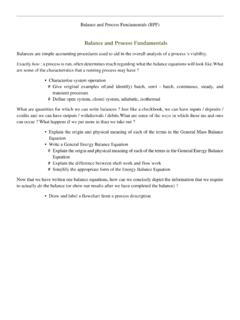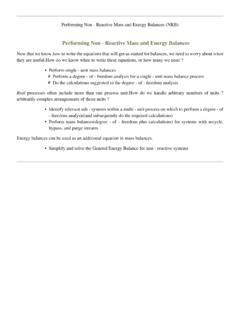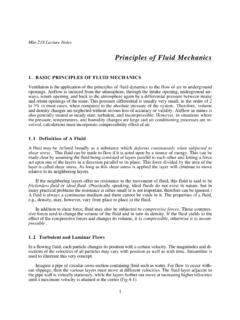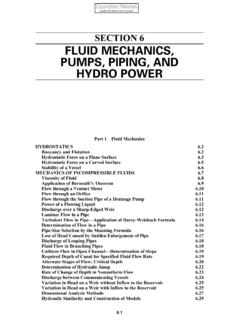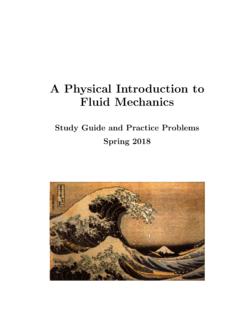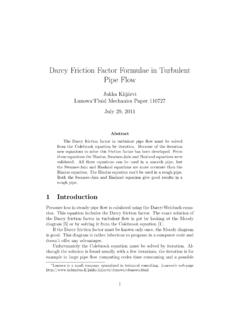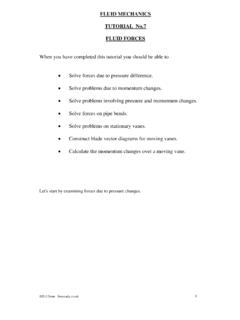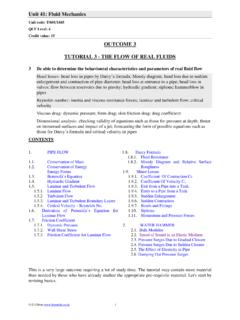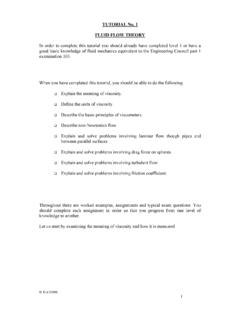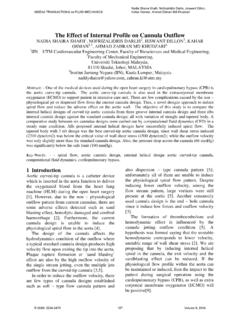Transcription of LTR: Fluid Drag - University of Pittsburgh
1 LTR: Fluid drag Not surprisingly, as a Fluid flows past a solid object it exerts a force on the solid. There are severalclasses of force typically discussed in Fluid mechanics , but the two most common are drag and :The drag force is the component of the force from the Fluid on the solid that is in the directionparallel to the flow (here denoted as the x direction).DEFINITION:The lift force is the component of the force from the Fluid on the solid that is in the directionperpendicular to the flow (here denoted as the y direction).In both the case of drag and lift the forces arise from two sources: Fluid friction (viscousforces), and non-uniform pressure distributions (pressure forces).
2 NOTE:Lift forces are only very weakly dependent on friction. they are primarily components of the drag force that arise from friction and pressure are given "specialnames":DEFINITION:The skin drag /friction is the portion of the drag force that arises due to shear stresses(viscous effects).DEFINITION:The form drag is the portion of the drag force that arises due to normal stresses (pressureeffects).As the above equations would imply, the components of the drag may be analyticallycalculated if the pressure and shear stress distributions are known (and we will do this later);however, in many cases, these calculations are difficult and experimental measurements ofthese components are useful :Distinguish between lift, drag , skin friction, and form drag .
3 LTR: Friction Factors and drag Coefficients In performing drag experiments, as with any transport experiments, it is useful to calculate/measuredimensionless quantities (for reasons of generality, scale invariance, etc.).Taking the frictional force per unit surface area to represent the shear stress, we can make adimensionless group using the Fluid density and velocity to get:DEFINITION:The coefficient of skin friction or the Fanning friction factor is the ratio of the totalnormalized ( , dimensionless) shear stress acting on the surface of a.
4 The Fanning friction factor is the one most often used by chemical engineersIf instead we base our dimensionless group more on the "head losses" (a pressure-related drag tobe discussed next) we get the Darcy friction factor, . While the Darcy factor is more common ingeneral engineering, it can simply be shown to be 4 times as big as the Fanning friction factor, so becareful which is which!DEFINITION:The drag coefficient is a more general dimensionless group that is the ratio of the totalnormalized drag ( , not simply skin drag ) acting on the surface of a solid. Here, we usethe total projected area rather then the surface :Typically in internal flows (pipe flows and friends) we are interested primarily in the skindrag, and use friction factors.
5 In external flows, form drag plays a larger role and we tendto use the (total) drag and ChartsFor laminar flow in a pipe, we can analytically show that the (Fanning) friction factor isgiven by:In turbulent flows, however, things are more difficult, as the friction factor depends stronglyon the pipe roughness:For a very smooth pipes a correlation is given as:For turbulent flow in a rough pipe:An expression for transitional flow is given by:Perhaps the easiest way to obtain friction factors is to use the popular Moody charts [onpage 173 (or 188 for 4th Ed.) of your text].
6 OUTCOME:Calculate friction factors from correlations and read friction factors off chartsTEST YOURSELFC alculate the friction factor for a water flow though a smooth 1in ID pipe at (an averageof) 10 m/s. LTR: Friction Factors and drag Coefficients Example OUTCOME:Calculate friction factors from correlations and read friction factors off chartsTEST YOURSELFC alculate the friction factor for a water flow though a smooth 1in ID pipe at (an averageof) 10 we calculate the Reynolds number:For flow through a circular pipe, this would be considered a turbulent flow.
7 Using theMoody charts, we get .Alternatively, we can use the correlation for a turbulent flow in a very smooth pipe:Using "solver" (or similar) and/or trial-and-error, we get using this method. LTR: drag in External Flows In addition to the correlations for internal (pipe) flows discussed previously, there are a number ofexpressions and charts for drag on submersed objects (external flows) in the of the most famous drag formulas is that of Stoke's drag , used for a viscously dominated flow:NOTE:This expression is useful for viscous fluids, but also for small particles (recall the definitionof the Re!)
8 Can you show that the drag coefficient in Stoke's flow is:As the flow becomes "faster" the character of the wake behind the blunt body changes and thus theform drag increases On Page 141 (or 153 for 4th Ed.) a chart shows the behavior of as a functionof :Use friction factors and/or drag coefficients to calculate drag on submersed objects (externalflows) and for internal flowsTEST YOURSELFC alculate the drag on a Nolan Ryan fastball (100 mph; cm diameter). LTR: drag in External Flows Example OUTCOME:Use friction factors and/or drag coefficients to calculate drag on submersed objects (externalflows) and for internal flowsTEST YOURSELFC alculate the drag on a Nolan Ryan with just about all drag -related problem, we must first calculate the Reynolds number:For flow past a sphere, we can get the drag coefficient from the chart on page 153.
9 If we now want to calculate the drag force from this we use the definition of the dragcoefficient:Rearranging to get the drag force, :which gives us: LTR: drag in Pipes You may have noticed that the normalizing " drag pressure" used thus far has been , whichis often called the dynamic pressure. Another common way to denote "pressure" losses due to drag isto quote them as head :The head loss is the energy lost per unit weight of the losses for straight lengths of pipe are directly related to the friction factor and constitute "majorlosses" in pipe flow:Head losses for bends and other pipe components are related to an empirical (experimentallymeasured) factor called the loss coefficient/factor, Ki (see page 175 (or 190 in 4th Ed.))
10 For values inpipe bends) and constitute "minor losses" in pipe flow:Another examples of loss coefficient/factor is for pipe constrictions, where:or pipe enlargements, where:NOTE:The terms "major" and "minor" losses do not necessarily denote which is larger, simplywhich is most common!In order to use head losses to calculate pressure drops, we use the following equation (which wewill derive later in the course):OUTCOME:Estimate friction losses in pipes and pipe networksTEST YOURSELFWhat are the units of a head loss? LTR: drag in Pipes Example OUTCOME:Estimate friction losses in pipes and pipe networksTEST YOURSELFYou are analyzing the flow between the hot water heater and the shower in a ranch-stylehome (so that elevation changes may be neglected).
